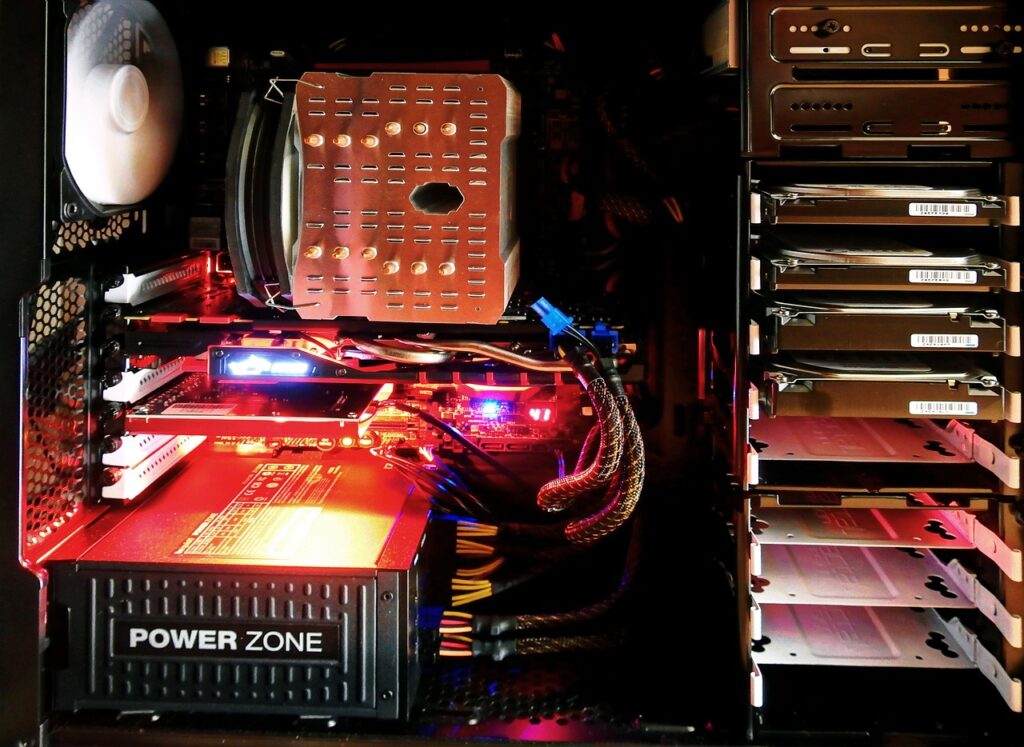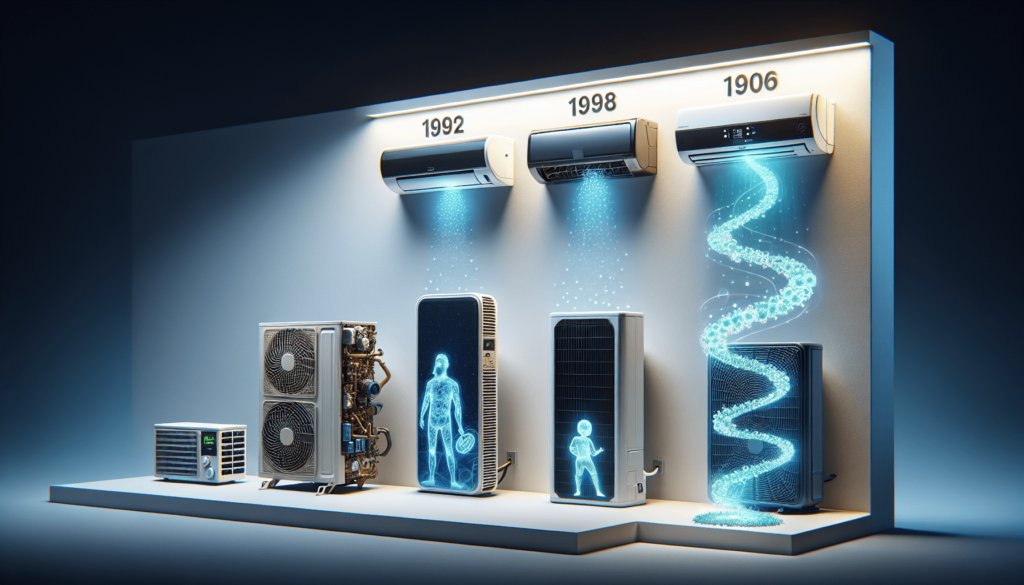Are you curious about what lies ahead for mini-split AC technology? Look no further! In this article, we will take a sneak peek into the future of mini-split ACs and explore the exciting advancements that await us. From enhanced energy efficiency to improved air purification capabilities, get ready to discover the innovations that will revolutionize the way we cool our homes and workplaces. So, buckle up and get ready to be amazed by the possibilities that lie ahead in the world of mini-split AC technology!
Understanding Mini-Split AC Systems
Defining mini-split AC system
A mini-split AC system, also known as a ductless AC system, is a type of air conditioning system that consists of two main components: an outdoor compressor unit and one or more indoor air handling units. Unlike traditional central air conditioning systems that require ductwork, mini-split systems are designed to cool or heat specific rooms or areas in a building without the need for extensive ductwork installation.
How mini-split AC systems function
Mini-split AC systems operate by transferring heat from the indoor environment to the outdoor unit. When cooling is desired, the refrigerant in the indoor unit absorbs heat from the indoor air and carries it to the outdoor unit where it is released. In the case of heating, the process is reversed, with heat being absorbed from the outdoor air and released indoors. This dual functionality makes mini-split AC systems ideal for year-round temperature control.
The benefits and limitations of existing mini-split AC technology
One of the main advantages of mini-split AC systems is their flexibility in terms of installation. With the absence of ductwork, these systems can be easily retrofitted into existing buildings or installed in new constructions with minimal disruption. Additionally, individual temperature control in each room allows for customized comfort and energy savings. However, it is important to note that mini-split systems may have higher upfront costs compared to central AC systems. Additionally, the indoor air handling units can be visible and may require regular maintenance and cleaning.
Current State of Mini-Split AC Technology
Current technological advancements in mini-split ACs
Mini-split AC technology has seen significant advancements in recent years. Improved compressor designs, variable-speed fans, and advanced airflow control systems have contributed to better energy efficiency and overall performance. Some models now feature wireless control options, allowing users to adjust temperature settings remotely through smartphones or other smart devices. Furthermore, advancements in noise reduction technology have addressed one of the common concerns associated with early mini-split models.
Analysis on the market demand for mini-split ACs
The market demand for mini-split AC systems has been steadily increasing due to several factors. One of the primary drivers is the growing trend towards energy-efficient and eco-friendly cooling solutions. Additionally, the versatility and zoning capabilities of these systems make them an attractive option for both residential and commercial applications. The rise in home renovations and the need for targeted cooling or heating in specific areas has also contributed to the demand for mini-split ACs.
Consumer feedbacks on current systems
Consumer feedback on existing mini-split AC systems has generally been positive. Many users appreciate the flexibility to cool or heat individual rooms and the ability to customize temperature settings. The quiet operation of some models is also well-received, as it minimizes noise disturbances. However, a common concern expressed by some consumers is the initial cost of installation, which can be higher compared to traditional central AC systems. Additionally, occasional issues with maintenance and repairs have been reported, although these can vary depending on the specific brand and model.

This image is property of pixabay.com.
Evolution of Mini-Split AC Technology
Historical development of mini-split AC technology
The development of mini-split AC technology dates back several decades. Early models were primarily used in commercial settings, such as computer rooms and small offices, where a ductless cooling solution was required. Over time, advancements in compressor technology, refrigerants, and system controls have paved the way for more efficient and cost-effective mini-split AC systems.
Major innovations over the years
Several major innovations have shaped the evolution of mini-split AC technology. The introduction of inverter technology, which allows the compressor to adjust its speed based on cooling demands, has significantly improved energy efficiency. The use of environmentally friendly refrigerants, such as R410A, has also become more prevalent, reducing the impact on the ozone layer. Wireless control options, including Wi-Fi integration and smart home compatibility, have simplified user interactions and enhanced convenience.
The influence of evolving environmental and energy regulations on development
Evolving environmental and energy regulations have played a significant role in shaping the development of mini-split AC technology. Stricter energy efficiency standards have prompted manufacturers to focus on improving system performance to meet these requirements. Additionally, environmental concerns have driven the industry to adopt eco-friendly refrigerants and reduce greenhouse gas emissions associated with cooling technologies. These regulations have pushed for innovation and continuous improvement in mini-split AC systems.
Emerging Technologies in Mini-Split AC Systems
Innovative methods in energy efficiency
The pursuit of higher energy efficiency in mini-split AC systems has led to the exploration of various innovative methods. One such method is the integration of advanced sensors and software algorithms to optimize cooling performance based on occupancy and weather conditions. Energy recovery ventilation systems, which reuse waste heat or cool outdoor air before it enters the system, are also being implemented to further improve energy efficiency.
Development in AI and automation technologies
The development of AI and automation technologies is revolutionizing the capabilities of mini-split AC systems. Machine learning algorithms can analyze historical usage patterns and adjust temperature settings automatically to optimize comfort and energy consumption. Additionally, advancements in occupancy sensors and smart thermostats enable the systems to adapt to occupants’ behavior and preferences, providing a truly personalized cooling experience.
Advancements in IoT integration
The integration of the Internet of Things (IoT) in mini-split AC systems allows for enhanced connectivity and control. With IoT integration, users can monitor and control their HVAC systems remotely, receive notifications for maintenance or filter changes, and even receive energy usage reports. This level of connectivity and data analytics enables users to make informed decisions to improve energy efficiency and overall system performance.
Progress in material technologies
Advancements in material technologies are also driving innovation in mini-split AC systems. The development of more efficient heat exchangers, such as microchannel coils, allows for improved heat transfer efficiency and reduced refrigerant usage. Additionally, the use of advanced insulation materials and coatings helps minimize energy losses and ensures optimal performance. These material advancements contribute to overall system efficiency and performance.

This image is property of pixabay.com.
Energy Efficiency in Future Mini-Split AC Systems
How the energy efficiency of mini-split ACs might improve
The energy efficiency of mini-split AC systems is expected to improve through various technological advancements. Continued research and development in compressor design and control algorithms will result in even higher energy efficiency ratings. New refrigerants with lower global warming potential (GWP) will also enable more sustainable cooling. Integration with renewable energy sources, such as solar panels, will further reduce the carbon footprint of mini-split AC systems.
Technologies driving energy efficiencies
Several technologies are driving energy efficiencies in mini-split AC systems. Inverter compressor technology, which adjusts the compressor speed based on cooling demands, remains a key factor in optimizing energy consumption. Smart sensors and algorithms that analyze environmental and occupancy data enable the system to adjust cooling output precisely, avoiding unnecessary energy usage. Additionally, advanced insulation materials and improved heat transfer components contribute to reduced energy losses.
The potential impact on energy costs
The improvement in energy efficiency of mini-split AC systems will have a positive impact on energy costs for consumers. Higher efficiency means reduced energy consumption, leading to lower utility bills. By optimizing cooling output based on the specific needs of each room or area, energy waste is minimized, resulting in additional long-term cost savings. This shift towards energy-efficient systems aligns with the growing demand for sustainable and cost-effective cooling solutions.
Smart and Automated Mini-Split AC Systems
Predictions for AI integration in future mini-split ACs
The integration of AI in future mini-split AC systems holds great potential. AI algorithms can learn from users’ preferences and behavior patterns, adjusting temperature settings automatically to optimize comfort while minimizing energy usage. Real-time weather data can also be incorporated to further enhance system performance and efficiency. With AI integration, mini-split AC systems will become smarter and more intuitive, providing a seamless and customized cooling experience.
Potential benefits and challenges of automation
Automation in mini-split AC systems offers several benefits. Automated temperature adjustments based on occupancy or time schedules eliminate the need for manual operation, ensuring optimal comfort without user intervention. Additionally, automation can optimize energy consumption by adjusting cooling output according to real-time usage patterns, resulting in energy savings. However, challenges may arise in terms of system reliability and user acceptance. Dependence on automation requires robust system design and thorough testing to ensure efficiency and reliability.
Consumer expectations for smart mini-split AC systems
As smart home technology continues to gain popularity, consumers have high expectations for smart mini-split AC systems. Seamless integration with existing smart home ecosystems, such as voice control and remote access through mobile apps, is expected. Users also expect user-friendly interfaces and intuitive controls to easily customize settings. Energy usage monitoring and smart energy management features are desired to provide users with insights and control over their cooling systems.

This image is property of pixabay.com.
Integration of IoT in Future Mini-Split AC Systems
Possible IoT enhancements for next-gen mini-split ACs
The integration of IoT in future mini-split AC systems opens up possibilities for various enhancements. Enhanced connectivity can allow for real-time monitoring of energy usage and system performance, providing users with valuable insights for optimizing energy consumption. Predictive maintenance and filter replacement notifications can ensure the system operates at peak efficiency. Furthermore, IoT integration can enable demand response capabilities, allowing the system to adjust cooling output based on utility signals to support grid reliability.
The implications of more integrated systems
The integration of mini-split AC systems with other IoT devices and systems has significant implications. Combined with smart thermostats and home energy management systems, mini-split AC systems can work in harmony with other appliances to optimize energy usage throughout the entire home. Integration with weather forecast data and occupancy sensors can further improve system efficiency and comfort. These integrated systems have the potential to transform the way we cool and heat our homes, creating a more sustainable and comfortable living environment.
Security considerations with IoT-enabled air conditioning
As with any IoT-enabled device, security considerations are of utmost importance. Ensuring robust cybersecurity measures to safeguard personal data is essential. Manufacturers must implement encryption protocols and regular software updates to address potential vulnerabilities. User authentication mechanisms should be in place to prevent unauthorized access to the system. Educating users on best security practices, such as creating strong passwords and avoiding suspicious downloads, is crucial in maintaining a secure IoT-enabled mini-split AC system.
Environmental Impact of Future Mini-Split AC Systems
Future environmental footprint of mini-split ACs
Future mini-split AC systems are expected to have a reduced environmental footprint. The use of refrigerants with low global warming potential (GWP) will minimize their impact on climate change. Continued advancements in energy efficiency will also result in reduced energy consumption, contributing to lower greenhouse gas emissions. Additionally, the integration of renewable energy sources and the optimization of cooling output based on real-time data will further reduce the environmental impact of these systems.
Coping with the growing demand for cooling while reducing emissions
As the demand for cooling continues to grow, it is crucial to find ways to meet this demand while reducing emissions. Mini-split AC systems offer a solution by providing targeted cooling to specific areas, avoiding the need to cool the entire building unnecessarily. The integration of energy-efficient technologies, renewable energy sources, and smart controls enables the reduction of emissions while maintaining comfort. This approach promotes sustainability and reduces the strain on power grids during peak cooling periods.
Potential environmental regulations
With increased awareness of climate change and the importance of energy conservation, it is likely that environmental regulations will continue to evolve. Stricter regulations may be implemented to reduce the use of refrigerants with high global warming potential and promote the adoption of energy-efficient cooling technologies. Additionally, more stringent energy efficiency standards may be enforced to drive innovation and encourage the development of more sustainable mini-split AC systems. Adhering to these regulations will be crucial for manufacturers and consumers alike.

Future Market Trends of Mini-Split AC Systems
Market size and growth predictions
The market for mini-split AC systems is projected to experience significant growth in the coming years. Factors such as increasing demand for energy-efficient cooling solutions, rising trends in home renovations, and the need for personalized comfort are driving this growth. The market size is expected to expand as more consumers become aware of the benefits offered by mini-split AC systems and seek environmentally friendly and cost-effective cooling solutions.
Potential key players in the industry
Various key players are expected to shape the future market of mini-split AC systems. Established HVAC manufacturers with a strong track record in producing reliable and efficient cooling systems are likely to dominate the market. Additionally, technological giants that specialize in smart home automation and IoT devices may play a significant role in the integration of advanced technologies into mini-split AC systems. Collaborations between traditional HVAC manufacturers and tech companies may drive innovation and market expansion.
Future price trends and affordable cooling solutions
As technology advances and market competition increases, it is expected that the prices of mini-split AC systems will become more affordable. Economies of scale, streamlined manufacturing processes, and increased market demand will contribute to price reductions. Additionally, government incentives and rebates aimed at promoting energy-efficient solutions may further reduce the upfront costs. These price trends will make mini-split AC systems more accessible to a wider range of consumers, providing affordable and efficient cooling solutions for homes and businesses.
Conclusions: What Consumers can Expect from Future Mini-Split AC Technology
Summarizing the future of mini-split AC technology
The future of mini-split AC technology promises significant advancements in energy efficiency, smart capabilities, and integration with IoT systems. These improvements will provide consumers with greater control, convenience, and comfort in their cooling experience. Mini-split AC systems will continue to prioritize sustainability, with reduced environmental impact through the use of eco-friendly refrigerants and optimized energy consumption.
Potential hurdles in the development and adoption of these technologies
While the future of mini-split AC technology looks promising, there are potential hurdles that need to be overcome. One challenge is the initial cost of installation, which may deter some consumers from adopting these systems. Manufacturers and policymakers must work together to ensure incentives and financing options are available to make mini-split AC systems more accessible. Additionally, ensuring compatibility and interoperability with existing smart home ecosystems will be crucial for a seamless user experience.
Advice to consumers in terms of future buying decisions
For consumers considering mini-split AC systems for their cooling needs, it is important to evaluate their specific requirements and preferences. Factors such as room size, installation feasibility, and desired features should be taken into account. Researching reputable brands and models, considering energy efficiency ratings, and consulting with HVAC professionals can help make an informed buying decision. Furthermore, exploring potential financial incentives and rebates can help mitigate the upfront costs associated with installation.
In conclusion, the future of mini-split AC technology holds great promise in terms of energy efficiency, smart capabilities, and sustainability. The integration of advanced technologies and the adoption of eco-friendly practices will provide consumers with more control, convenience, and cost-effective cooling solutions. By staying informed and considering their specific needs, consumers can navigate the evolving market and make the right choices for their future mini-split AC systems.


